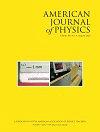空气是如何让一本合上的书变慢的
IF 0.9
4区 教育学
Q3 EDUCATION, SCIENTIFIC DISCIPLINES
引用次数: 0
摘要
当两个平面相互接近时,中间的流体会被加速并从两侧高速喷出。这种情况在日常生活中经常出现,例如当你踏入水坑时会产生水花,或者当你拍手或合上书时会产生气流。对于这些系统,流体的惯性会抵消加速度,从而在平面上产生巨大的非线性力。在这项工作中,我们研究的是合上书的情况。这种情况下的流体运动比较容易利用机械能守恒进行建模,并利用 MEMS 陀螺仪传感器进行测量。这项研究揭示了两块平板碰撞时产生的不寻常力,学生可以在家里进行实验。本文章由计算机程序翻译,如有差异,请以英文原文为准。
How the air slows a closing book
When two flat surfaces approach each other, the fluid in between is accelerated and ejected from the sides at large speeds. This situation occurs often in everyday life, such as when you step in a puddle and create splashes of water, or when you clap your hands or close a book and create jets of air. For these systems, the inertia of the fluid resists the acceleration, creating large nonlinear forces on the flat surfaces. In this work, we study the case of a closing book. The fluid motion in this case is relatively easy to model, using the conservation of mechanical energy, and to measure using a MEMS gyroscopic sensor. This study reveals the unusual forces that occur when two plates collide in an experiment that can be performed by students at home.
求助全文
通过发布文献求助,成功后即可免费获取论文全文。
去求助
来源期刊

American Journal of Physics
物理-物理:综合
CiteScore
1.80
自引率
11.10%
发文量
146
审稿时长
3 months
期刊介绍:
The mission of the American Journal of Physics (AJP) is to publish articles on the educational and cultural aspects of physics that are useful, interesting, and accessible to a diverse audience of physics students, educators, and researchers. Our audience generally reads outside their specialties to broaden their understanding of physics and to expand and enhance their pedagogical toolkits at the undergraduate and graduate levels.
 求助内容:
求助内容: 应助结果提醒方式:
应助结果提醒方式:


